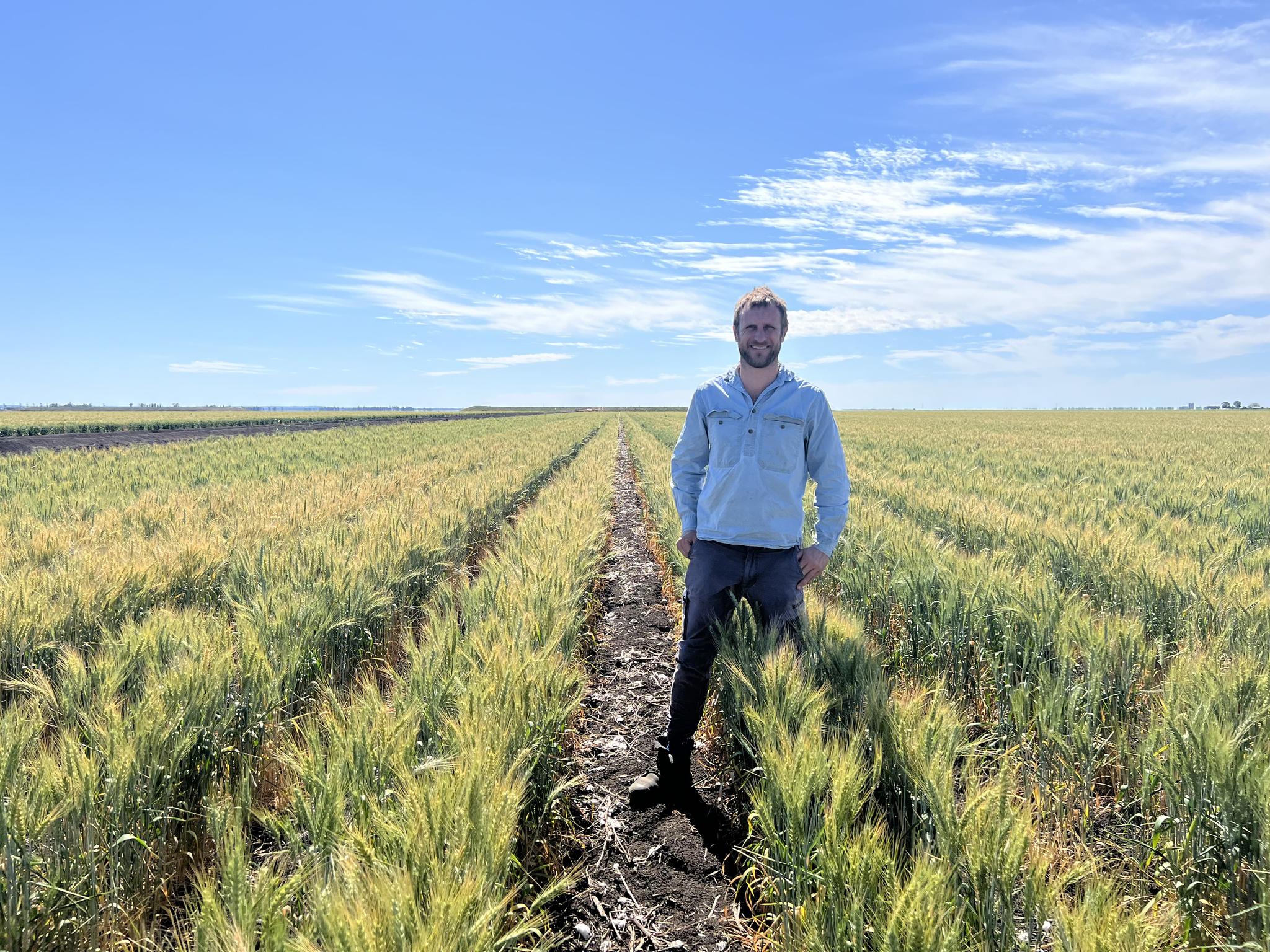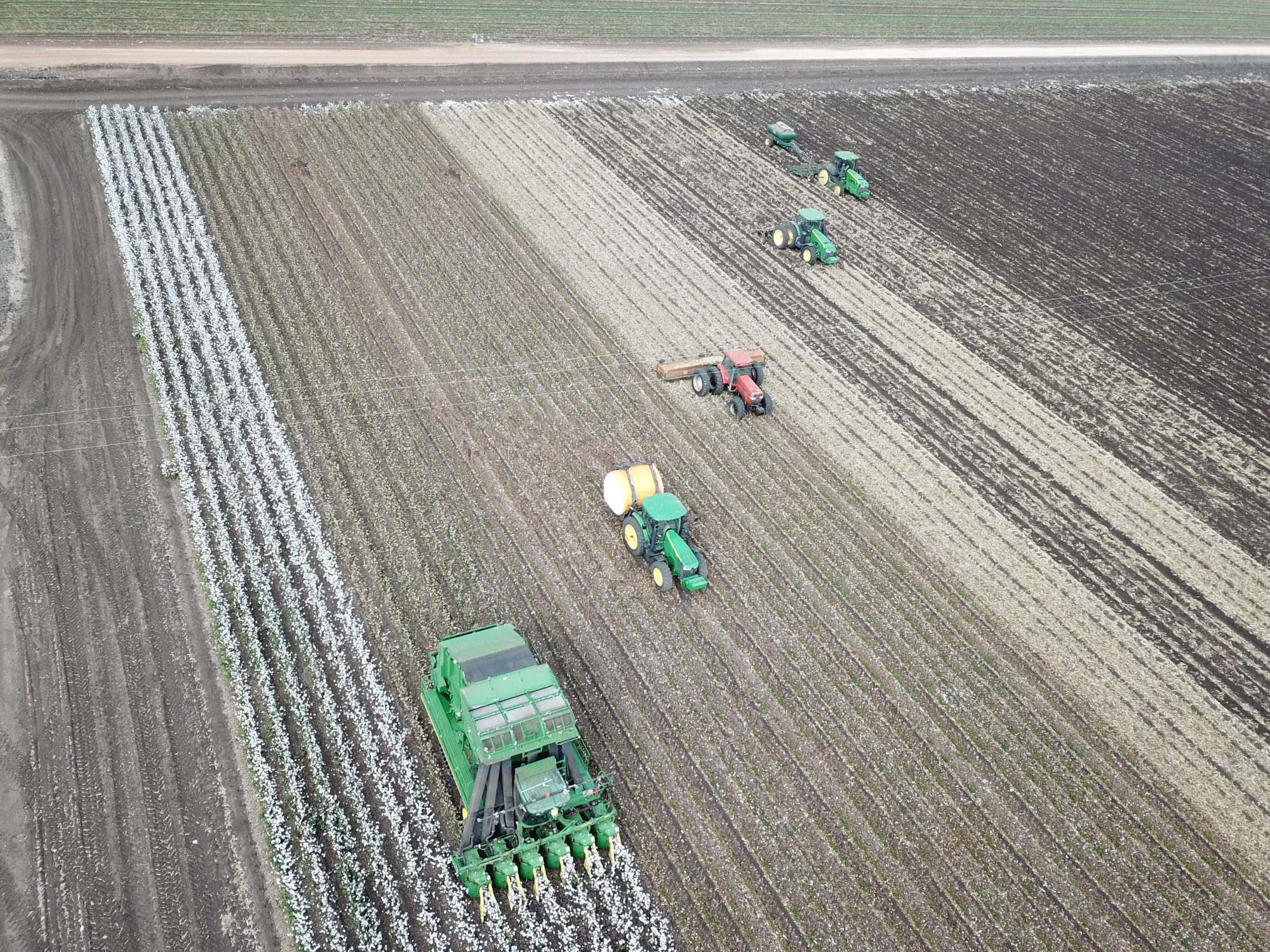Cereal covers central to a soil focus on the Downs

Grant Porter in a cover crop of Lancer wheat at Athelgrove last week. Mr Porter says winter cereal crops help release compaction caused by picking cotton during a wet harvest, and retaining stubble during the fallow period conserves soil moisture for the next cotton crop. Pictures supplied
Cereal cover crops have proved their worth during the past five years, as Eastern Downs cotton grower Grant Porter focuses on improving soil health and reducing how often the land is ploughed between crops.
A third generation farmer, Mr Porter works with his father, Brett, and brothers, Tom and Mark, under the Porters Farming banner at Attleigh, Warrawee, Ivanhoe, Athelgrove, Springfields and Neylons between Brookstead and Cecil Plains, west of Toowoomba.
They crop about 1100ha, producing summer crops, such as cotton, sorghum and mung beans, and winter crops of wheat, barley and chickpeas.
Soils are self-mulching black, cracking clay, typical of the floodplain between the Condamine River and its north branch.
“We’re gifted with very nice soil, although it’s slightly acidic, which makes it a little bit of a challenge for our plants to take up the nutrients that we put in,” Mr Porter said.
In the past three years about 500 tonnes of chicken manure has been spread on paddocks they want to improve. Cow manure from feedlots is spread after cotton on the other fields.
Mr Porter said using wheat as a cover crop between cotton crops had helped release compaction caused by picking cotton during a wet harvest.
“We’ve really noticed the benefits from the wheat, particularly releasing the soil, but then also acting as a cover across the summer and the winter as well,” he said.
“We’ve been leaving that stubble in there to capture more rainfall and keep the soil alive. It’s also good for weed competition.
“What we’re trying to do is to plough less in these paddocks, because historically, every other practice for every other crop around here has gone down the minimum till path.
“But when you have flood irrigation, you are forced to set your field up to allow water to run down it. So we’re really trying to minimise how much we plough this country, only disturbing the soil that actually needs to move.”
Conventionally the land is broadacre ploughed numerous times for furrow preparation, but Mr Porter said using their in-house engineered plough they were able to minimise tillage this season while preparing for the coming cotton crop.
“It’s been pretty incredible, because the soil was actually in really good condition and soft from just sitting there and the rain falling on it,” he said.
“I’m really happy with the hills that we’ve pulled – they’re quite nice. The best part about it is that any clods that were created were thrown on top and exposed to the weather. There’s none hidden down deep, because we haven’t touched the plant line soil.”
Average annual rainfall is about 600mm, which is often distributed fairly evenly throughout the year, although storms can make it more variable.
Cotton crops are irrigated using a siphon and flood furrow irrigation system that draws from water stored in ring tanks, ranging in size from 75 megalitres to 350 megalitres.
As well as being filled from bores, the tanks capture tailwater and some overland flows.
The Porters budget one megalitre to the hectare for cotton and make sure they have access to enough water for three irrigations during the season, considering any more than that a bonus.
This year they intend to plant 350ha of cotton once conditions start to get “nice and hot”, which Mr Porter expects to begin in late October and continue through to mid-November.
The area will be split between three varieties: the proven performers Sicot 746B3F and Sicot 606B3F, and the new XtendFlex variety, Sicot 761B3XF, which has shown promise in trials.
In the past fortnight they were spreading cow manure at 6t/ha and giving the hills a final run through.
The cotton will be planted dry at 17 seeds a metre using a modified John Deere MaxEmerge XP on 40 inch (1.016m) solid rows, with 40kg/ha of Starter Z applied under the seed.
Mr Porter said the heavier seeding rate had been chosen to offset the risk of poor germination from bad weather or a disease outbreak.
The cotton will be flushed up, and followed a few weeks later with a glyphosate spray. They’ll also be hoping for rain to apply the residual metolachlor for controlling problem grass weeds, such as feathertop Rhodes grass and barnyard grass.
An Austil twin row single disc implement will be used to apply urea, potash and Starter Z before the first watering. Depending on the condition of the furrows, they will be scuffled if needed to help irrigation and drainage.

Harvesting cotton at Warrawee on the Eastern Downs on May 31.
Mr Porter said there were minimal pest or disease problems in last year’s crop, which yielded more than 10 bales per hectare, despite dropping fruit during a hot spell in February.
He attributed this result to a combination of varietal resistance and soil improvements achieved using a nutrient bank system devised by their agronomist, Matthew Holding, of Meteora Agronomic Consulting, Cecil Plains.
“Tests have shown we’re deficient in potassium, so we’ve added that and we’re seeing much more consistent results across our farms,” he said.
“The other one that is playing a part is the soil biology. Not ploughing as much, having the wheat in there, I think that really helps with the disease pressure. We’ve also seen the return of worms in the fields, which is something I haven’t seen before.”
Integrated pest management and testing higher trigger levels for spraying mirids based on crop growth stage have also shown it’s possible to reduce pesticide use.
Last year, they held off spraying until monitoring showed mirid density at more than eight per metre and decided the spiders and beneficial insects weren’t keeping up.
Mr Porter said they also deliberately left some paddocks unsprayed – on the basis of research that found plants could compensate for mirid damage – and were unable to see any difference in yield.
“This year it gives us more confidence, now that we’ve done that trial, to just let it go even further,” he said.
“Once you start spraying and you start damaging the beneficials, you end up finding yourself having to spray again and again.
“We’re trying to get more holistic, more regenerative in what we do. It saves a lot of work, saves a lot of diesel, but I also think that it’s going to give us a better result at the end of the day.”
